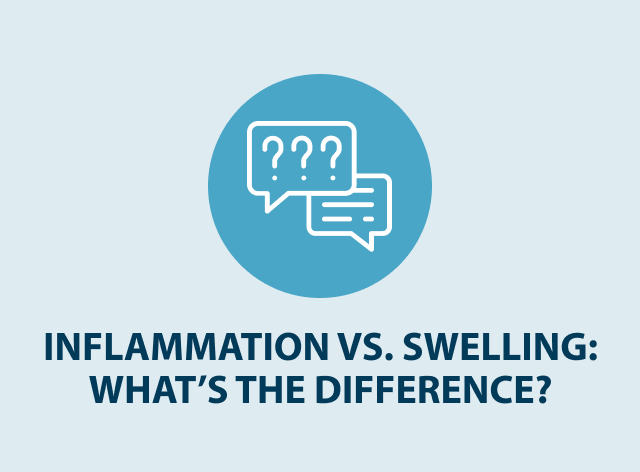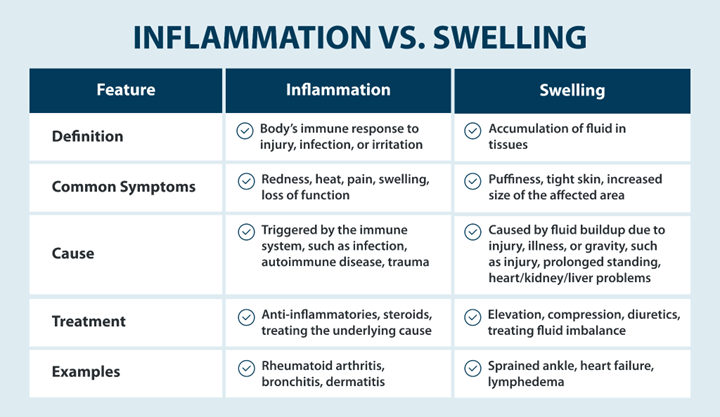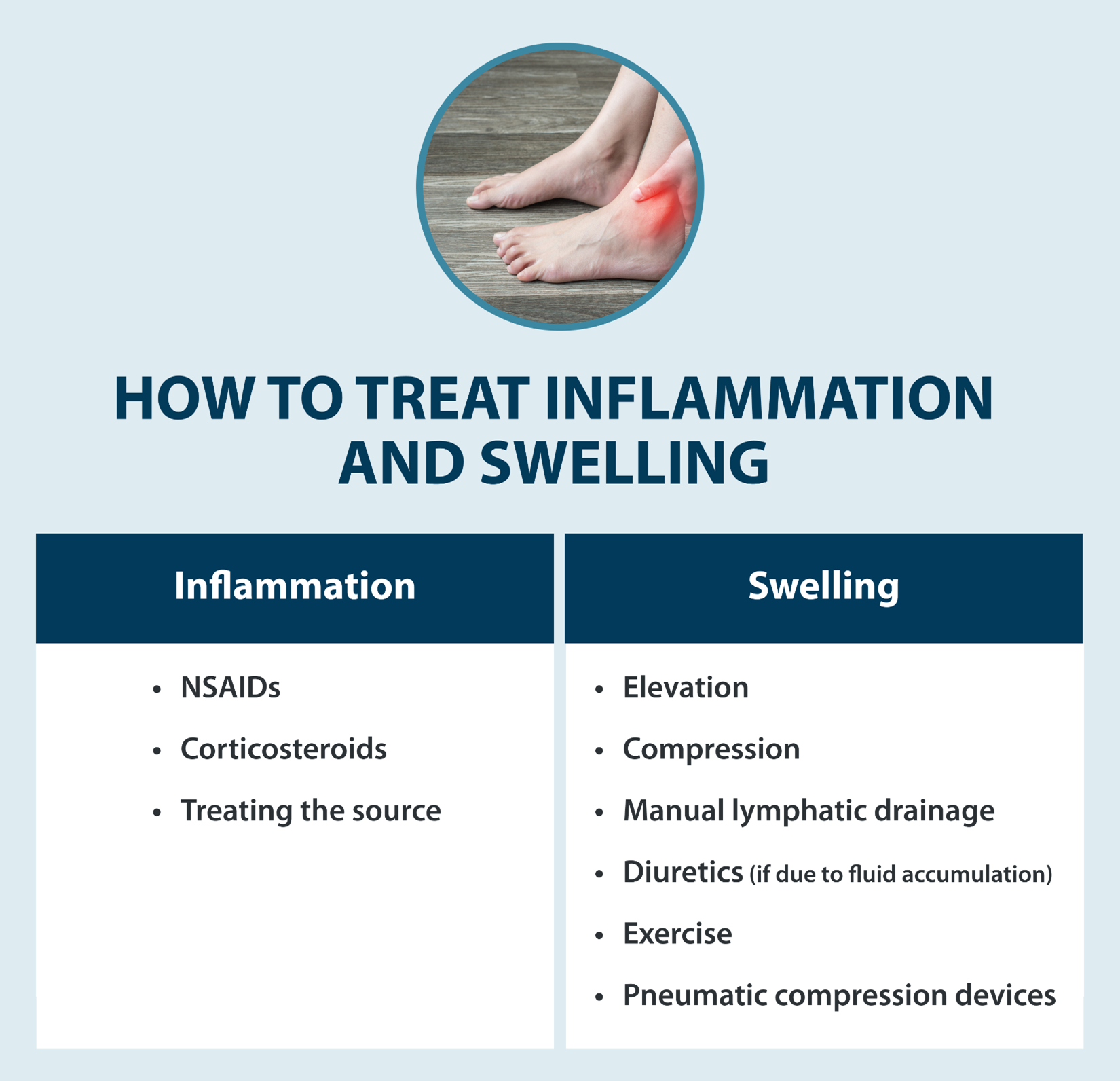Chronic Venous Insufficiency
Review our guide on chronic venous insufficiency (CVI) to better understand the symptoms, causes, and treatment options to get the care you need.
Read More

Many people use the terms “inflammation” and “swelling” interchangeably, but they’re actually two different symptoms. While these two conditions can occur together and often do, understanding what distinguishes them can help you better manage your health and receive the most effective treatment when needed.
The confusion between swelling vs. inflammation is understandable, as they often appear together. However, recognizing whether you’re dealing with inflammation, swelling, or both can make a significant difference in how you approach treatment and recovery. Keep reading to learn the difference between inflammation vs. swelling and what that means for you.
Swelling, medically known as edema, occurs when excess fluid accumulates in the body’s tissues.1 This fluid accumulation creates visible puffiness and can make affected areas feel tight, heavy, or uncomfortable. Unlike inflammation, swelling is primarily a mechanical process rather than an immune response.2
Several factors can trigger swelling throughout your body. Poor circulation often leads to fluid retention, particularly in your legs and feet. Injuries can cause localized swelling as blood vessels leak fluid into surrounding tissues. Heart, kidney, or liver conditions may also result in widespread swelling, as these organs struggle to maintain proper fluid balance.1
You can usually recognize swelling by its distinctive appearance and feel. The affected area typically looks puffy or enlarged, with skin that appears stretched or shiny. When you press on swollen tissue, it might leave an indentation that slowly fills back in.2 Common examples include swollen ankles after a long flight or fluid buildup in the legs due to heart failure. Additionally, the limb may also ache or feel heavy.
The causes of swelling vary widely depending on your overall health and circumstances. Prolonged sitting or standing, hormonal changes, certain medications, and underlying medical conditions can lead to fluid retention. Some people notice swelling after eating salty foods or during hot weather when their body retains more fluid.2
Inflammation is your body’s natural defense mechanism against injury, infection, or irritation. This complex biological process involves your immune system releasing various chemicals and cells to protect damaged tissues and begin the healing process.3
The usual signs of inflammation are redness, heat, pain, swelling, and loss of function. These symptoms occur because your body increases blood flow to the affected area and releases chemicals that help fight off threats and initiate the healing process.4
Various triggers can spark inflammatory responses throughout your body. Autoimmune disorders cause your immune system to mistakenly attack healthy tissues, resulting in chronic inflammation. Infections prompt immediate inflammatory responses as your body fights off bacteria, viruses, or other pathogens. Physical injuries activate inflammation to protect damaged areas and coordinate healing.4
Common examples of inflammatory conditions include rheumatoid arthritis, where joints become inflamed and painful, sore throats resulting from viral or bacterial infections, and skin rashes caused by allergic reactions.
So, is inflammation the same as swelling? Simply put, no. The primary distinction between swelling and inflammation lies in their underlying mechanisms and purposes. Inflammation is a complex biological process involving your immune system, blood vessels, and various chemical mediators that work together to protect and heal your body.
On the other hand, swelling is simply the accumulation of fluid in tissues, which can happen for many reasons unrelated to immune responses.

While inflammation often causes swelling as part of its protective process, swelling doesn’t always indicate inflammation. For instance, water retention from consuming excessive salt or prolonged periods of inactivity can cause swelling without triggering an inflammatory response. Similarly, untreated edema from heart or kidney problems involves fluid accumulation but may not involve active inflammation.
Understanding the differences between swelling and inflammation also explains why treatments differ between these conditions. Inflammatory swelling typically responds to anti-inflammatory medications and treatments that address the underlying immune response. Non-inflammatory swelling often improves with physical interventions, such as elevation, compression, or improving circulation through the lymphatic system.
The relationship between these conditions also explains why some treatments are more effective than others. If you’re dealing with inflammatory swelling, addressing only the fluid buildup without treating the underlying inflammation may provide temporary relief, but won’t solve the problem. Conversely, using anti-inflammatory treatments for non-inflammatory swelling might be unnecessary and potentially ineffective.
Many health conditions involve either inflammation, swelling, or both, making it important to understand which process is primarily at work. Once you have this information, you and your healthcare provider can work together to find the most appropriate treatment approach and understand what to expect during recovery.
Several conditions primarily involve inflammatory processes that can lead to various symptoms.4,5
These conditions include:
Other conditions primarily cause swelling through fluid accumulation rather than inflammatory processes. These include:1
Effective treatment depends on accurately identifying whether you’re dealing with inflammation, swelling, or both. Each condition responds to different approaches, and using the wrong treatment may provide little relief or could potentially worsen your symptoms.
Understanding how to manage chronic swelling is particularly important for individuals with ongoing health conditions. For swelling management, several approaches can help reduce fluid buildup and improve circulation, such as:
Learning how to perform a lymphatic massage can provide ongoing relief for people dealing with chronic swelling issues. Complete decongestive therapy encompasses multiple approaches for comprehensive management of swelling.

Inflammation treatment focuses on reducing the immune response and addressing underlying causes.5
Some people benefit from consulting specialists who treat swelling to develop comprehensive treatment plans. These professionals can help determine whether your symptoms primarily involve inflammation, swelling, or both, ensuring you receive the most appropriate care.
Knowing whether you’re dealing with inflammation, swelling, or both helps you get the right treatment and avoid wasting time on approaches that won’t work. The key is recognizing that these are separate processes that may require different solutions, even when they occur simultaneously.
At Tactile Medical, we understand that managing swelling and its underlying causes requires comprehensive solutions tailored to your specific needs. Our pneumatic compression devices and treatment protocols help people effectively manage various types of swelling, whether they stem from inflammatory conditions, circulatory issues, or other causes.
References
1. “Swelling – Heart and Blood Vessel Disorders.” Merck Manual Consumer Version, www.merckmanuals.com/home/heart-and-blood-vessel-disorders/symptoms-of-heart-and-blood-vessel-disorders/swelling.
2. “Edema.” Mayo Clinic, Mayo Foundation for Medical Education and Research, 28 July 2023, www.mayoclinic.org/diseases-conditions/edema/symptoms-causes/syc-20366493.
3. “NCI Dictionary of Cancer Terms.” Comprehensive Cancer Information – NCI, www.cancer.gov/publications/dictionaries/cancer-terms/def/inflammation.
4. Chen, Linlin, et al. “Inflammatory Responses and Inflammation-Associated Diseases in Organs.” Oncotarget, U.S. National Library of Medicine, 14 Dec. 2017, pmc.ncbi.nlm.nih.gov/articles/PMC5805548/.
5. “Inflammation: What You Need to Know.” Cleveland Clinic, 3 July 2025, my.clevelandclinic.org/health/symptoms/21660-inflammation.
Review our guide on chronic venous insufficiency (CVI) to better understand the symptoms, causes, and treatment options to get the care you need.
Read More
The lymphatic system helps our body fight diseases and infections. Find out more about the lymphatic system and its functions in this guide.
Read More
Lymphatic circulation is a key part of the immune system. Learn more about the role of the lymphatic system in the body.
Read More
When your lymphatic system isn’t functioning properly, fluid can build up in your body tissue and lead to swelling. Lymphedema is a medical condition characterized by swelling that can make life more difficult due to pain, decreased mobility, and other symptoms. Fortunately, there are several ways you can manage your...
Read More
Call us at 1.800.575.1900